
| WWT Shows | CLICK TO: Join and Support Internet Horology Club 185™ | IHC185™ Forums |

|
• Check Out Our... • • TWO Book Offer! • |
Welcome Aboard IHC185™  Internet Horology Club 185
Internet Horology Club 185  IHC185™ Discussion Site Main Page
IHC185™ Discussion Site Main Page  Horological Discussions, Questions and Answers
Horological Discussions, Questions and Answers  Clocks, Including 400-Day Discussions
Clocks, Including 400-Day Discussions  VERGE FUSEE CARRIAGE CLOCK - INFORMATION
VERGE FUSEE CARRIAGE CLOCK - INFORMATION
 Internet Horology Club 185
Internet Horology Club 185  IHC185™ Discussion Site Main Page
IHC185™ Discussion Site Main Page  Horological Discussions, Questions and Answers
Horological Discussions, Questions and Answers  Clocks, Including 400-Day Discussions
Clocks, Including 400-Day Discussions  VERGE FUSEE CARRIAGE CLOCK - INFORMATION
VERGE FUSEE CARRIAGE CLOCK - INFORMATIONGo  | New Topic  | Find-Or-Search  | Notify  | Tools  | Reply to Post  |  |
Hi, I have an old verge fusee carriage clock see picture attached and wanted to ask if anyone has any knowledge of it's origin or age. It is not Engliah and the fusee chain is smaller than normal fusees. Also, it does not have a dial and I wnated to ask if it was worth restoring. Thanks Norman 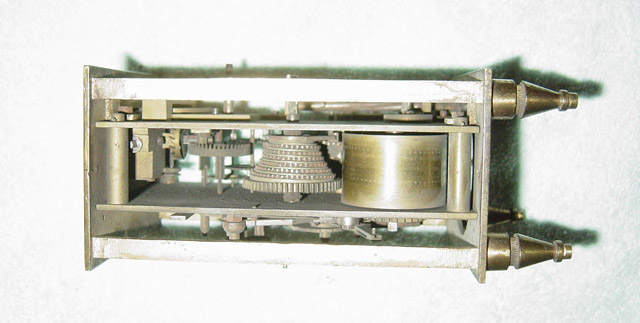 | |||
|
Hi Norman Any chance of a few more pictures taken at different angles ie the front plate and the back plate. It would be good also to have a bit of the history-how did you acquire it? If thats not too rude a question? I only say this only because on first sight the feet appear to be of different quality and design to the movement and I wonder if the frame could have been built around the movement and added later. Its a long shot of course and it maybe that the feet have just been added.Or indeed it could all be original but it might be good, as you have the clock,to check the feet, perhaps by unscrewing one, against the rest of the movement -look at the screw threads with an eyeglass this may give you a clue. You say its a verge a close up of this would be good. What is the pendulum like? Are their fixing holes or supports for the dial? Are there grooves for side glasses? | ||||
|
Thanks Clive, I have attached some more pictures to see the full clock. The clock has two strikes which used to hit a bell hidden in the bottom of the clock, The general feedback that I have had is that the clock is Austrian or French and dates to approx. 1800. Not sure of it's worth restoring - I acquired it at an auction in the US. The back of the clock may give a clue to the origin - their is a graduated scale with the letters l AND g AT EACH END. Also the 3 winding holes (1 FUSEE AND 2 SPRING) have the letters of G, S and W - does this help ?, I'd welcome any more information that you have. 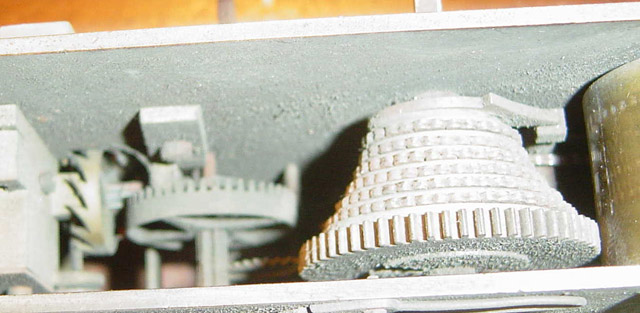 | ||||
|
Another picture 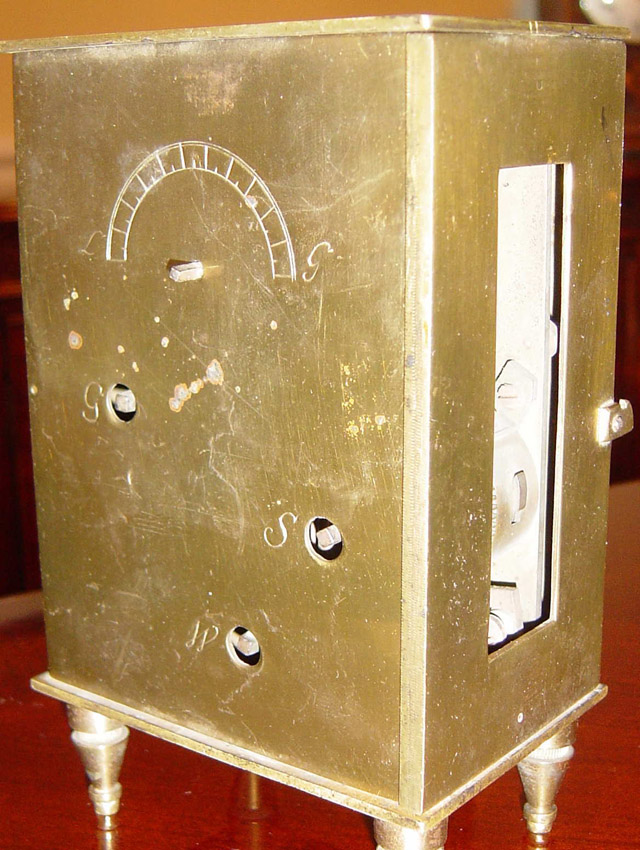 | ||||
|
And another 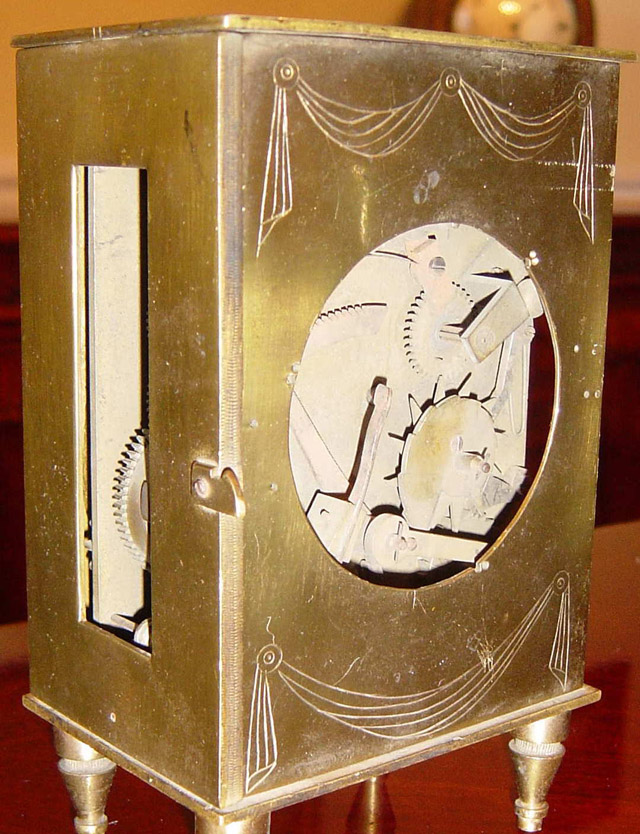 | ||||
|
another 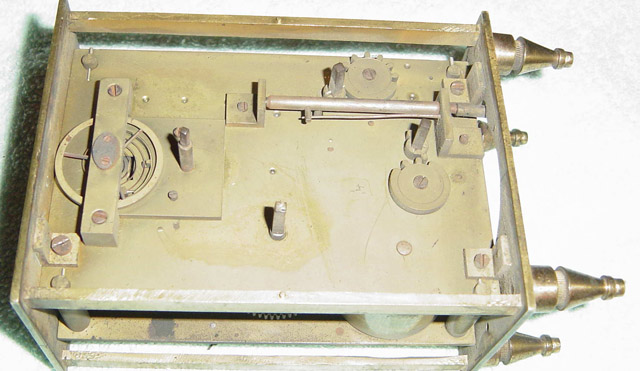 | ||||
|
finally  | ||||
|
Really interesting. I dont think its French but more likely Austrian. I'll get back to you when I've thought some more. I have an early Austrian clock I'll check whether there are any common features in design. I take it, it has two racks. If so it could be grand sonnerie i.e strikes at the quarters as well as the hour and quarters. Any signs that it could have had two gongs or bells? | ||||
|
Thanks Clive, I have attached a picture of the bottom of the clock. There are 2 gongs (both missing the gong head) so I think a bell used to be here. I thought it could be a grande sonnerie. Any idea of the age ?. Thanks for all your help. Norman  | ||||
|
Norman I've checked the quality and design of your front plate components against my Austrian grand sonnerie mantel clock which is circa 1800. There are significant differences so it has me doubting my initial view - French it could possibly be - I'll reserve judgement! The steel work of my Austian clock is very fine and the return springs are steel. It is quite difficult working from photographs on something like this. In Clocks and Watches of the Landrock collection, where I thought I might find something similar to your clock it says "The first movements of travelling clocks had a verge escapement and fusee,the hours and quarters were struck on bronze bells situated between the feet of hte case. The alarum could be set on a special chapter ring on the centre of the dial." All also have a ring for carrying.Your "ring" could have been on a carrying case. I think most clocks for carrying had carry cases at the time. There are four pictures showing clocks from France and Germany.A german one has side windows like yours they are dated around 1770. So this is a starting point. Check the screw heads are the slots chisel shaped (which is older) or do the slots have parallel sides? I've also checked Charles Allixs book "Carriage Clocks" this only supports the info in the other book. To be grand sonnerie I believe it should have two racks - I cannot see two in your pictures unless the clock is of different design or one rack is between the plates. I think your clock may have an alarm, look at your picture showing the back plate. It shows two discs with just a few teeth. Could one of these be the alarm train with a form of stop work to limit the running of the alarm.? I think you have a really exciting clock - sorry but its the sort of thing that I'd love to pick up at auction. If it were mine I'd restore it (but then I do my own restoration) If you had to have it restored commercially it could be a different matter. And I'm afraid I have no idea of the cost of doing so in the States. Even if I did I would need to examine the clock in person to assess properly. I'm pretty sure that with a little more research you will find something similar. But as I said personaly I think its a great clock. Hope this helps. Kind regards Clive | ||||
|
Norman, I don't know much about clocks, but I sure like it. It's unusual, and that's a real plus to me. I hope we see some more information about this one, now I'm curious! Nice Clock! Sheila | ||||
|
Hi Clive, I checked the screws - all appear to V-shaped slots which I think is the older design that you mentioned - where these types of screw used in the late 18th century or later. I think you are also correct on the alarm - there is a small spring housing for this mechanism. Thanks for all your help - learning more about this clock has been a lot of fun and very educational. Norman | ||||
|
Norman On screws I know that the first machine made pointed wood screws were made in 1851. I would suggest that machine made clock screws probably predate this slightly, so if I was to guess I would say that hand made clock screws with V shaped slots probably run up to about 1830 (in reality there would not be a firm date as people would use up old stock etc) With the info we have so far this would narrow down date of your clock to roughly 1770- 1830 | ||||
|
Thanks for all your help - this was a great discussion. Because of the feedback, I decided to list the clock on ebay and hopefully get more funds to get some of my other projects restored. Please feel free to bid (see below for link). Thanks Norman If the link does not get you there - search ebay on verge fusee and you should find it - it is probably the only one. http://cgi.ebay.com/ws/eBayISAPI.dll?ViewItem&rd=1&item...=STRK:MESE:IT&ih=001 | ||||
|
| Powered by Social Strata |
| Your request is being processed... |
|
Welcome Aboard IHC185™  Internet Horology Club 185
Internet Horology Club 185  IHC185™ Discussion Site Main Page
IHC185™ Discussion Site Main Page  Horological Discussions, Questions and Answers
Horological Discussions, Questions and Answers  Clocks, Including 400-Day Discussions
Clocks, Including 400-Day Discussions  VERGE FUSEE CARRIAGE CLOCK - INFORMATION
VERGE FUSEE CARRIAGE CLOCK - INFORMATION
 Internet Horology Club 185
Internet Horology Club 185  IHC185™ Discussion Site Main Page
IHC185™ Discussion Site Main Page  Horological Discussions, Questions and Answers
Horological Discussions, Questions and Answers  Clocks, Including 400-Day Discussions
Clocks, Including 400-Day Discussions  VERGE FUSEE CARRIAGE CLOCK - INFORMATION
VERGE FUSEE CARRIAGE CLOCK - INFORMATION©2002-2025 Internet Horology Club 185™ - Lindell V. Riddle President - All Rights Reserved Worldwide

